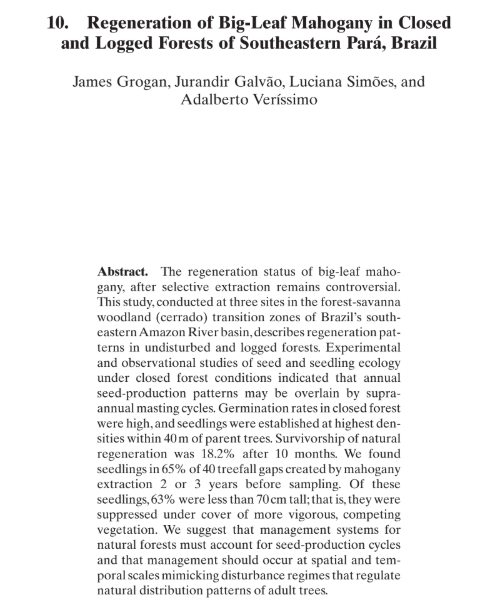We can't find the internet
Attempting to reconnect
Something went wrong!
Hang in there while we get back on track

Regeneration of big-leaf mahogany in closed and logged forests of southeastern Pará, Brazil
07/06/03| Título | Regeneration of Big-Leaf Mahogany in Closed and Logged Forests of Southeastern Pará, Brazil |
|---|---|
| Autores | James Grogan (a) Jurandir Galvão (a) Luciana Simões Adalberto VerÍssimo (a) |
| Vinculação dos autores | (a) Instituto do Homem e Meio Ambiente da Amazônia (Imazon) – Belém (PA), Brasil |
| Ano de publicação | 2003 |
| Meio de publicação | Big-Leaf Mahogany: Genetics, Ecology, and Management. Ecological Studies 159. (1a Edição., pp. 193–208) |
| DOI (Digital Object Identifier) | https://doi.org/10.1007/0-387-21778-9_10 |
Grogan, J., Galvão, J., Simões, L., VerÍssimo, A. (2003). Regeneration of Big-Leaf Mahogany in Closed and Logged Forests of Southeastern Pará, Brazil. In: Lugo, A.E., Figueroa Colón, J.C., Alayón, M. (eds) Big-Leaf Mahogany. Ecological Studies, vol 159. Springer, New York, NY.
 Abstract
Abstract
The regeneration status of big-leaf mahogany, after selective extraction remains controversial. This study, conducted at three sites in the forest-savanna woodland (cerrado) transition zones of Brazil’s southeastern Amazon River basin,describes regeneration patterns in undisturbed and logged forests. Experimental and observational studies of seed and seedling ecology under closed forest conditions indicated that annual seed-production patterns may be overlain by supraannual masting cycles. Germination rates in closed forest were high,and seedlings were established at highest densities within 40 m of parent trees. Survivorship of natural regeneration was 18.2% after 10 months. We found seedlings in 65% of 40 treefall gaps created by mahogany extraction 2 or 3 years before sampling. Of these seedlings,63% were less than 70 cm tall;that is,they were suppressed under cover of more vigorous, competing vegetation. We suggest that management systems for natural forests must account for seed-production cycles and that management should occur at spatial and temporal scales mimicking disturbance regimes that regulate natural distribution patterns of adult trees.
 PT
PT
 ES
ES
 EN
EN

